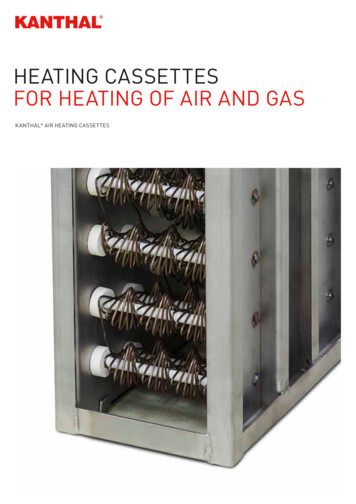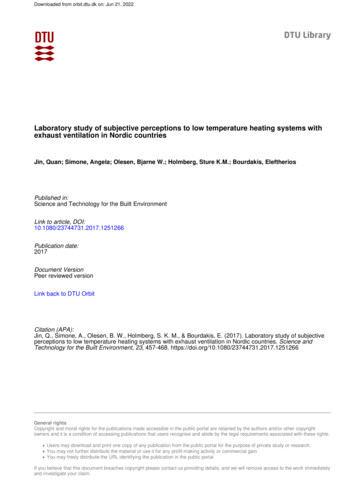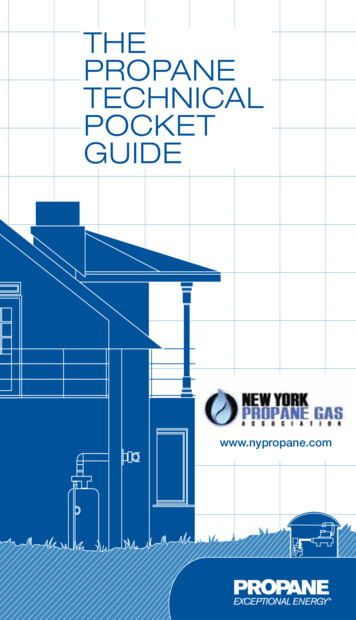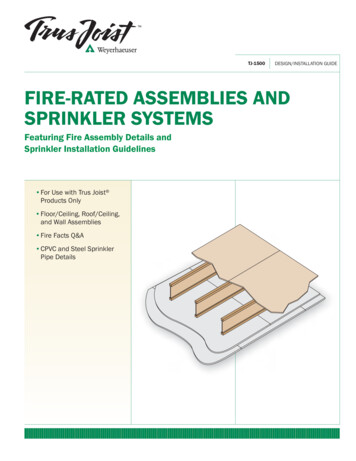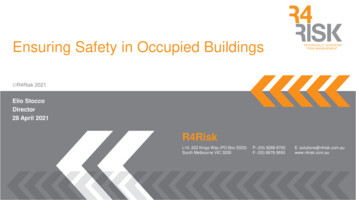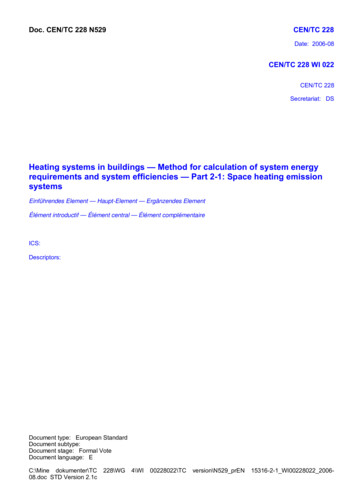
Transcription
Doc. CEN/TC 228 N529CEN/TC 228Date: 2006-08CEN/TC 228 WI 022CEN/TC 228Secretariat: DSHeating systems in buildings — Method for calculation of system energyrequirements and system efficiencies — Part 2-1: Space heating emissionsystemsEinführendes Element — Haupt-Element — Ergänzendes ElementÉlément introductif — Élément central — Élément complémentaireICS:Descriptors:Document type: European StandardDocument subtype:Document stage: Formal VoteDocument language: EC:\Mine dokumenter\TC08.doc STD Version 2.1c228\WG4\WI00228022\TCversion\N529 prEN15316-2-1 WI00228022 2006-
prEN 15316-2-1:2006 (E)ContentsPageForeword .4Introduction.51Scope .62Normative references.633.13.2Definitions and symbols (to be updated according to the umbrella document and otherrelated standards).7Definitions .7Symbols and units.84Relation to other EPBD-standards.955.15.25.35.45.55.65.75.8Principle of the method.10Primary energy calculation.10Thermal energy required for heat emission .10Auxiliary energy Wem .11Recoverable heat losses Qrh,em and un-recoverable heat losses Qnr,em .11Heat demand for space heating, building heat requirement Qh .11Heat losses Ql,em .12Calculation periods .12Spatial division of the space heating system.1266.16.1.16.36.3.16.3.26.3.36.4Energy calculations for a heat emission system .12Non-uniform temperature distribution .12General approach for calculation of energy losses due to a non-uniform temperaturedistribution .12Use of tabled efficiency values for a non-uniform temperature distribution .14Use of tabled values for the equivalent increase in internal temperature due to a nonuniform temperature distribution.14Heat loss of embedded surface heating devices due to additional transmission to theoutside .14Control of the indoor temperature .16General Approach.16Method using control efficiency. .16Method using equivalent increase in internal temperature .18Auxiliary energy, We .1877.17.2Recommended calculation methods.18Method using efficiencies.19Method using equivalent increase in internal temperature .206.1.26.1.36.2Annex A (informative) ENERGY LOSSES OF THE HEAT EMISSION SYSTEM adapted from Germanregulation DIN 18599 .21A.1Heat emission .21A.1.1 Efficiencies for free heating surfaces (radiators); room heights 4 m .22A.1.2 Efficiencies for component integrated heating surfaces (panel heaters) (room heights 4 m).24A.1.3 Efficiencies for electrical heating (room heights 4 m).25
prEN 15316-2-1:2006 (E)A.1.4A.1.5A.1.6A.1.7A.1.8Efficiencies air heating/domestic ventilation (room heights 4 m).26Efficiencies air heating (non-domestic ventilation systems) (room heights 4 m) .26Efficiencies for room spaces with heights 4 m (large indoor space buildings) .26Efficiencies for room spaces with heights 10 m .28Auxiliary energy QH,ce,aux .29Annex B (Informative) Equivalent increase in internal temperature - adapted from the Frenchregulation RT2005.33B.1General .33B.2Zones .33B.3Spatial variation .34B.4Control accuracy .35Annex C (Informative) Bibliography .36Document type: European StandardDocument subtype:Document stage: Formal VoteDocument language: EC:\Mine dokumenter\TC 228\WG 4\WI 00228022\TC version\N529 prEN 15316-2-1 WI00228022 200608.doc STD Version 2.1c
prEN 15316-2-1:2006 (E)ForewordThis document (EN 15316-2.1:2006) has been prepared by Technical Committee CEN/TC 228 “Heating systemsin buildings”, the secretariat of which is held by DS.This document is part of a series of standards developed for implementation of the European EnergyPerformance of Buildings Directive (EPBD)The subjects covered by CEN/TC 228 are the following:-design of heating systems (water based, electrical etc.);-installation of heating systems;-commissioning of heating systems;-instructions for operation, maintenance and use of heating systems;-methods for calculation of the design heat loss and heat loads;-methods for calculation of the energy performance of heating systems.-methods for design and dimensioning embedded, radiant surface heating and cooling systemsHeating systems also include the effect of attached systems such as hot water production systems.All these standards are systems standards, i.e. they are based on requirements addressed to the system as awhole and not dealing with requirements to the products within the system.Where possible, reference is made to other European or International Standards, a.o. product standards.However, use of products complying with relevant product standards is no guarantee of compliance with thesystem requirements.The requirements are mainly expressed as functional requirements, i.e. requirements dealing with the function ofthe system and not specifying shape, material, dimensions or the like.The guidelines describe ways to meet the requirements, but other ways to fulfil the functional requirements mightbe used if fulfilment can be proved.Heating systems differ among the member countries due to climate, traditions and national regulations. In somecases requirements are given as classes so national or individual needs may be accommodated.In cases where the standards contradict with national regulations, the latter should be followed.
prEN 15316-2-1:2006 (E)IntroductionThis standard constitutes the specific part related to space heating emission, of a set of standards determiningmethods for calculation of energy losses/requirements of space heating systems and domestic hot watersystems in buildings.This standard specifies the structure for calculation of the additional heat losses and energy requirements of aheat emission system for meeting the building net energy demand.The calculation method is used for the following applications:— calculation of the additional energy losses in the heat emission system;— optimisation of the energy performance of a planned heat emission system, by applying the method toseveral possible options;— assessing the effect of possible energy conservation measures on an existing heat emission system, bycalculation of the energy requirements with and without the energy conservation measure implemented.The user shall refer to other European Standards or to national documents for input data and detailed calculationprocedures not provided by this standard.Document type: European StandardDocument subtype:Document stage: Formal VoteDocument language: EC:\Mine dokumenter\TC 228\WG 4\WI 00228022\TC version\N529 prEN 15316-2-1 WI00228022 200608.doc STD Version 2.1c
prEN 15316-2-1:2006 (E)1ScopeThe scope of this specific part is to standardise the required inputs, the outputs and the links (structure) of thecalculation method in order to achieve a common European calculation method.The energy performance may be assessed either by values of the heat emission system efficiency or by valuesof the increased space temperatures due to heat emission system inefficiencies.The method is based on an analysis of the following characteristics of a space heating emission systemincluding control:— non-uniform space temperature distribution;— emitters embedded in the building structure;— control accuracy of the indoor temperature.The energy required by the emission system is calculated separately for thermal energy and electrical energy inorder to determine the final energy, and subsequently the corresponding primary energy is calculated.The calculation factors for conversion of energy requirements to primary energy shall be decided on a nationallevel.2Normative referencesThe following referenced documents are indispensable for the application of this document. For dated references,only the edition cited applies. For undated references, the latest edition of the referenced document (includingany amendments) applies.EN 12828, Heating systems in building – Design for water based heating systemsEN 12831, Heating systems in buildings - Method for calculation of the design heat load.EN 15316-1, Heating systems in buildings - Method for calculation of system energy requirements and systemefficiencies – Part 1: GeneralEN 15316-2.3, Heating systems in buildings - Method for calculation of system energy requirements and systemefficiencies – Part 2.3: Space heating distribution system.EN 15232. Calculation methods for energy efficiency improvements by the application of integrated buildingautomation systemsEN ISO 7345:1995, Thermal insulation - Physical quantities and definitions (ISO 7345:1987)EN ISO 13790, Thermal performance of buildings - Calculation of energy use for space heating (ISO13790:2007)
prEN 15316-2-1:2006 (E)3 Definitions and symbols (to be updated according to the umbrella document andother related standards)3.1 DefinitionsFor the purposes of this standard, the definitions given in EN ISO 7345:1995 and the following definitionsapply:3.1.1calculation periodtime period (time step) considered for the calculation of the heat losses and gains (e.g. year, month, day, hourboosted sub-period) of the heating system3.1.2energy requirements for heatingenergy to be delivered to the heating system to satisfy the heat demand of the building3.1.3final energyenergy required for the space heating of the building including auxiliary energy3.1.4heat demand, buildingheat to be delivered to the heated space to maintain the internal set-point temperature of the heated space3.1.5heated spaceroom or enclosure heated to a given set-point temperature3.1.6heating system heat losses, emissionheat losses through the building envelope due to non-uniform temperature distribution, control inefficienciesand losses of emitters embedded in the building structure3.1.7heating system heat losses, totalsum of the heat losses from the heating system, including recoverable heat loss3.1.8performance factor, emissionratio between the energy demand for space heating with a uniform internal temperature distribution in theheated space and the energy requirements for space heating with a non-ideal heat emission system causingnon-uniform temperature distribution and a non-ideal room temperature control3.1.9primary energyenergy that has not been subject to any conversion or transformation process (e.g. oil in the oil fields)3.1.10recoverable (usable) system heat losspart of the heat loss, from the space heating and domestic hot water system, which may be recovered to lowerthe heat demand for space heating3.1.11recovered (used) system heat losspart of the recoverable system heat loss which lowers the heat demand for space heating and which is notdirectly taken into account by reduction of the heating system heat losses7
prEN 15316-2-1:2006 (E)3.1.12thermal zonepart of the heated space with a given set-point temperature, in which a negligible spatial variation of theinternal temperature is assumed3.2 Symbols and unitsFor the purposes of this standard, the following symbols and units (see Table 1) and indices (see Table 2)apply:Table 1: Symbols and unitsName of quantitySymbol8Unitm2Asurface areabtemperature reduction factoresystemfactor)Eprimary energyJfconversion factor-ggain/loss ratio-kpart of recoverable auxiliary energy-Lsteady state part of heat loss%Qquantity of heat, energyperformancecoeff.(performance-J2Rthermal resistancem ·K/Wttime, period of timesTthermodynamic temperatureKUheat transfer coefficientxpercentage of lossesWelectrical auxiliary energyΦthermal powerηefficiency-γuutilisation factor-θcelsius temperatureW/m2·K%kWhW C
prEN 15316-2-1:2006 (E)Table 2: Indicesavg averagepprimaryccontrolhheating energyout output from systemeexternaliinternalrininput to systemstr stratificationem emissionembeddedemb4gs gainsrecoveredinc increasedttotalindiceselelectrical energyllossxffinalmmedium (heating)Δ additionalGGroundnrnon recovered lossesRelation to other EPBD-standardsThe present standard follows the general concept outlined in EN15316-1The user shall refer to other European Standards or to national documents for input data and detailedcalculation procedures not provided by this standard. The interaction with other standards is shown in Figure 1.The method for calculation of the building net heating energy is provided by EN ISO 13790. The results of thisstandard is used in EN 15316-2-3 as input to calculations for the space heating distribution system or in EN15316-4.x as input for the calculations for the heat generators. More detailed information on control systems isfound in EN15232.Figure 1: Sample sub-system for heat emission. The symbols used are explained in 3.29
prEN 15316-2-1:2006 (E)5Principle of the method5.1 Primary energy calculationHeat losses for heat emission and control of the indoor temperature in a building depends on:— the building energy need for space heating (building thermal properties and the indoor and outdoorclimate);— non-uniform internal temperature distribution in each thermal zone (stratification, emitters along outsidewall/window, differences between air temperature and mean radiant temperature);— emitters embedded in the building structure towards the outside or unheated spaces;— control of the operative temperature (local, central, set-back , thermal mass, etc);— auxiliary consumption;The calculation of emission losses shall take into account:— energy interaction between type of emitters (radiator, convector, floor/wall/ceiling heating systems) andspace ;— type of room/zone thermal control strategy and equipment (thermostatic valve, P, PI, PID control, etc) andtheir capability to reduce the temperature variations and drift;— position and characteristics of emitters.Based on these data, the following output parameters for the heat emission sub-system, including control,shall be calculated:— total emission system heat losses;— auxiliary energy consumption;— recoverable heat losses.The calculation may be based on tabulated values or more detailed calculation methods. In section 7 twoconcepts are given with recommended default values in Annex A and B.The net energy demand for space heating, without taking into account the system losses, shall be calculatedunder standardised conditions according to EN ISO 13790 or similar national method.The system losses are calculated separately for thermal energy and electrical energy, in order to determinethe final energy, and subsequently the corresponding primary energy is calculated (EN15316-1).5.2 Thermal energy required for heat emissionThe thermal energy required for heat emission, Qin,em, is given by:Qin ,em Qout ,em k Wem Ql ,emwhere:10[J](2)
prEN 15316-2-1:2006 (E)Qout ,emthermal output of the heat emission system in Joule (J). This is equal to the net heating energyof the building, Qh , (EN ISO 13790);kpart of recoverable auxiliary energy (-);Ql,emheat losses in Joule (J).5.3 Auxiliary energy WemAuxiliary energy, normally in the form of electrical energy, is used for fans which facilitate the heat emission(fan coil), valves and control. Part of the auxiliary energy may be recovered as heat Qw,em :Qw,em k · Wem[J](3)5.4 Recoverable heat losses Qrh,em and un-recoverable heat losses Qnr,emNot all of the calculated heat losses, Ql,em, are necessarily lost. Some of the heat losses are recoverable.However, only part of the recoverable heat losses is actually recovered. This depends on the utilisation factor(gain/loss ratio), because if the gains of a heated space are very high in comparison with the losses of thespace, only few gains can be recovered (see EN ISO 13790).For the heat emission system, only part of the auxiliary energy may be recovered as heat. Only heat losses toan unheated space or to the outside (embedded, back of radiator) are regarded as losses.5.5 Heat demand for space heating, building heat requirement QhThe heat requirement for the building or a part of the building, Qh, shall be calculated according to EN ISO13790 or similar national method as:Qh Ql - γu · Qgs[J](4)where:Qlheat losses in Joule (J);Qgsheat gains in Joule (J);γuutilisation factor (-).This calculation takes into account the heat losses of the building envelope and the recovered part of the totalheat gains (metabolic gains from occupants, power consumption of lighting devices, household appliancesand solar gains). However, it does not take into account the space heating and domestic hot water systemlosses due to non-uniform temperature distribution, control inefficiencies, recoverable losses and auxiliaryenergy.Depending on the input data chosen for the set-point temperature, EN ISO 13790 gives a method to calculatedirectly the sum of the heat demand and the heat losses of the heat emission system, without differentiatingone from the other. The way to determine the internal temperature for taking into account part of the emissionheat loss is defined in the present standard.The effects of intermittent space heating with an ideal programming device can be calculated according to ENISO 13790 and are taken into account in determination of the heat demand, Qh. The effects of a non-idealprogramming device (late or early heating up) are taken into account in the present standard as heat emissionsystem heat loss.The effect of a non-ideal space temperature control is taken into account in the present standard.11
prEN 15316-2-1:2006 (E)5.6 Heat losses Ql,emThe heat losses of heat emission are calculated as:Q l,em Q em,str Q em,emb Q em,c[J](5)where:Q em,strheat loss due to non-uniform temperature distribution in Joule (J);Q em,embheat loss due to emitter position (e.g. embedded) in Joule (J);Q em,cheat loss due to control of indoor temperature in Joule (J).Methods for calculation of these heat losses are given in 6.5.7 Calculation periodsThe objective of the calculation is to determine the annual energy demand of the space heating emissionsystem. This may be done in one of the following two different ways: by using annual data for the system operation period and perform the calculations using annual averagevalues; by dividing the year into a number of calculation periods (e.g. year, month, week, day, hour, boosted subperiod) and perform the calculations for each period using period-dependent values and adding up theresults for all the periods over the year.5.8 Spatial division of the space heating systemA heating system may, as required, be split up in zones with different heat emission systems, and the heatloss calculations can be applied individually for each zone. The considerations given in EN 15316, part 1regarding splitting up or branching of the heating system shall be followed. If the principle of adding up theheat losses is respected, it is always possible to combine zones with different heat emission systems.6Energy calculations for a heat emission systemThis section give in details methods for calculation of losses in the heat emission systems. The concept isexemplified in two approaches in section 7 with default values in annexes:Method using efficiencies section 7.1, Annex AMethod using equivalent internal temperature increase section 7.2, Annex BThe two recommended methods may not give exactly the same results; but the same relative trent. The twomethods shall not be mixed.6.1 Non-uniform temperature distribution6.1.1 General approach for calculation of energy losses due to a non-uniform temperaturedistributionThe energy loss can be caused by (see Figure 2):-a temperature stratification, resulting in an increased internal temperature under the ceiling and upper partsof the room;12
prEN 15316-2-1:2006 (E)-an increased internal temperature and heat transfer coefficient near windows;-convection and radiation from the heating system through other outside surfaces.Figure 2: Effects due to non-uniform temperature distribution and position of heat emitterThe heat loss due to a non-uniform temperature distribution is calculated using the general equation for transmission heat loss, taking into account the increased internal temperature, θ i,inc, and the increased heattransfer coefficient, which is included in the U-value, Uinc, of the surface area exposed:Qem,emb Σ A · Uinc · (θi,inc - θe) · t[J](7)where:Aarea of the ceiling, outside wall behind heat emitter or window in square metres (m²);Uinccalculated from the insulation of the surface and the surface coefficient in Watts per square metres perKelvin (W/m²·K). This is influenced by the convective air flow from the heat emitter, reflective materialbehind the heat emitter, etc.θi,inclocally increased internal temperature in degrees Celsius ( C) which is a function of the heatingsystem and the surface temperature or the supply air temperature of the heating system;θeexternal temperature in degrees Celsius ( C)13
prEN 15316-2-1:2006 (E)time in hours (h).tCalculation of the net energy use according to EN 13790 is based on the assumption that air temperature andmean radiant temperature are equal and uniformly distributed. For systems with a significant part of radiantheating and spaces with large cold surfaces, the mean radiant temperature may differ significantly from the airtemperature. This will for convective systems result in an increased ventilation heat loss and for radiantheating systems result in a decreased ventilation heat loss.The calculations are in this standard simplified by using tabled efficiencies (6.1.2 or equivalent increase inspace temperature 6.1.3)6.1.2Use of tabled efficiency values for a non-uniform temperature distributionIf the efficiency,ηL ,of the internal temperature distribution of the heat emission system is given, the additionalheat loss Qem,str, can be calculated as:Qem, str 1 ηLηL Qh[J](8)Annex A provide examples of efficiency values for heat emission systems.6.1.3 Use of tabled values for the equivalent increase in internal temperature due to a non-uniformtemperature distribution.The heat loss due to a non-uniform temperature distribution may be calculated according to EN ISO 13790using an equivalent increased internal temperature. The equivalent increase in internal temperature may beused to calculate the corresponding increase in heat loss in two different ways:-by multiplying the calculated building heat demand, Qh, with a factor based on the ratio between theequivalent increase in internal temperature, Δθi, and the average temperature difference for the heatingseason between the indoor and outdoor temperature for the space:Qem,str Qh · ( 1 Δθi / (θi - θe,avg) )-[J](9)by recalculation of the building heat energy requirements, according to EN ISO 13790 or similar nationalmethod, using the equivalent increased internal temperature.The second method gives more accurate results.Annex B provides examples of values for the equivalent increase in internal temperature, Δθi, for differenttypes of heat emitters.6.2 Heat loss of embedded surface heating devices due to additional transmission to theoutsideThis applies to floor heating, ceiling heating and wall heating systems and similar.This is only considered as a loss when one side of the building part containing the embedded heating deviceis facing the outside, the ground, an unheated space or a space belonging to another building unit.If embedded heat emitters with different characteristics (e.g. insulation) are used in the heating installation, itis necessary to take this into account by separate calculations.14
prEN 15316-2-1:2006 (E)Note :If the increased temperature in the building element has been taken into account in the calculations accordingto EN ISO 13790, this shall not be done again. For a slab on ground, it is for large buildings important to use theequivalentU e value according to EN ISO13370 or EN 12831.The heat loss due to additional transmission to the outside is calculated as follows (see Figure 2):Necessary room heat emission:Qi A · Ui · (θm - θi) · t[J](10)Qex,a A · Uex · (θm - θex) · t[J](11)[J](12)Heat loss to the other side:Combining these equations gives:Qex,a [(Uex/Ui) · Qi A · Uex · (θi - θex)] · twhere:Asurface area with embedded heating device in square metres (m²);Uexheat transfer coefficient between the level of the heating medium and the outside, ground,neighbouring unit, or unheated space in Watts per square metres per degrees Celsius (W/m²· C);Uiheat transfer coefficient between the level of the medium and the heated space in Watts per squaremetres per degrees Celsius (W/m²· C);θmaverage temperature at the level of the heating medium in degrees Celsius ( C);θexexternal temperature, ground temperature, temperature in neighbouring unit or temperature inunheated space in degrees Celsius ( C);θiinternal temperature in degrees Celsius ( C);ttime in hours(h).Heat transfer to the ground can be calculated according to ISO EN 13370.Another way to express the heat losses of an embedded heat emitter is to present the losses as a percentageof the heat demand (heat requirement) of the space.The heat losses are calculated as follows:Aemb x l emb Azone 100Qem ,emb Qh [J](13)where:Aemb surface area heated by the embedded emitter in square metres (m2);Aemb surface area of the zone in square metres (m2);xlpercentage of heat losses (between 0 and 100):15
prEN 15316-2-1:2006 (E)x l 100 Ri1 Rib U[%](14)where:Rithermal resistance of the building envelope component between the level of the heating medium andthe heated space in square metres by Kelvin per Watts (m2·K/W);Uheat transfer coef
EN 12831, Heating systems in buildings - Method for calculation of the design heat load. EN 15316-1, Heating systems in buildings - Method for calculation of system energy requirements and system efficiencies - Part 1: General EN 15316-2.3, Heating systems in buildings - Method for calculation of system energy requirements and system
